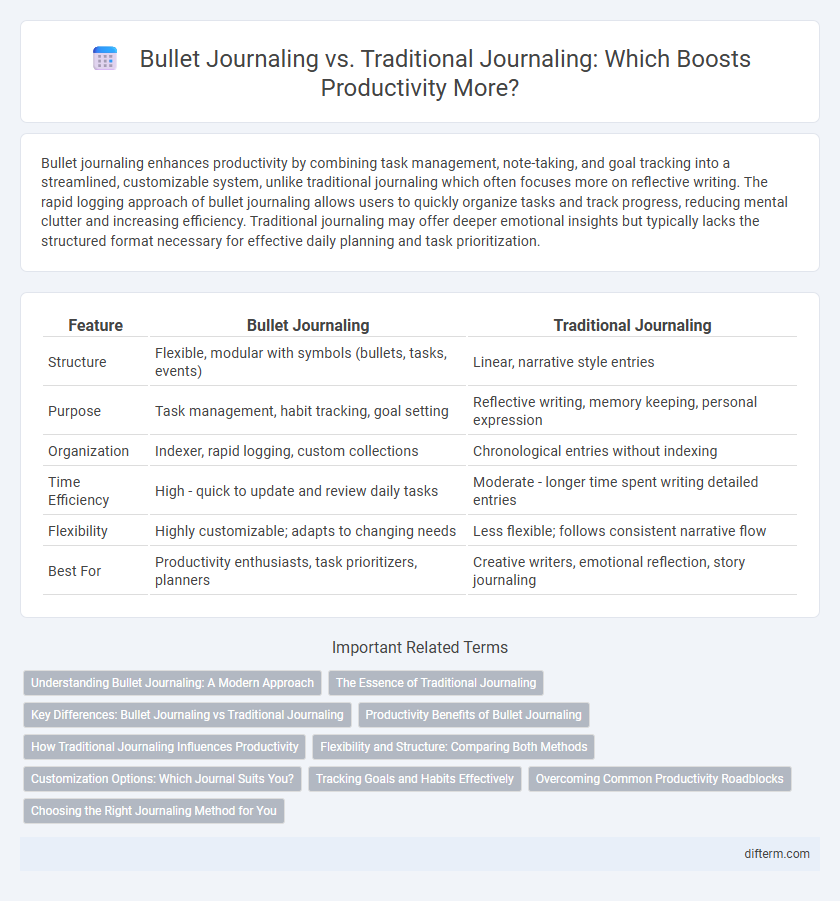Bullet journaling enhances productivity by combining task management, note-taking, and goal tracking into a streamlined, customizable system, unlike traditional journaling which often focuses more on reflective writing. The rapid logging approach of bullet journaling allows users to quickly organize tasks and track progress, reducing mental clutter and increasing efficiency. Traditional journaling may offer deeper emotional insights but typically lacks the structured format necessary for effective daily planning and task prioritization.
Table of Comparison
| Feature | Bullet Journaling | Traditional Journaling |
|---|---|---|
| Structure | Flexible, modular with symbols (bullets, tasks, events) | Linear, narrative style entries |
| Purpose | Task management, habit tracking, goal setting | Reflective writing, memory keeping, personal expression |
| Organization | Indexer, rapid logging, custom collections | Chronological entries without indexing |
| Time Efficiency | High - quick to update and review daily tasks | Moderate - longer time spent writing detailed entries |
| Flexibility | Highly customizable; adapts to changing needs | Less flexible; follows consistent narrative flow |
| Best For | Productivity enthusiasts, task prioritizers, planners | Creative writers, emotional reflection, story journaling |
Understanding Bullet Journaling: A Modern Approach
Bullet journaling offers a streamlined, customizable system that combines planning, task management, and reflection, enabling users to optimize productivity through rapid logging and flexible page layouts. Unlike traditional journaling, which often focuses on narrative entries and fixed formats, bullet journaling emphasizes concise symbols and modular organization to track goals, habits, and priorities efficiently. This modern approach leverages minimalistic design and adaptability to foster clearer focus and enhanced time management in daily routines.
The Essence of Traditional Journaling
Traditional journaling captures personal reflections and daily experiences in an unstructured format, fostering deep self-awareness and emotional processing. It emphasizes narrative flow and free expression, allowing users to explore thoughts without rigid guidelines. This method supports emotional clarity and memory retention by encouraging detailed storytelling and introspection.
Key Differences: Bullet Journaling vs Traditional Journaling
Bullet journaling emphasizes rapid logging with symbols and customization, allowing users to track tasks, events, and notes efficiently, while traditional journaling typically involves freeform writing focused on personal reflection or detailed entries. Bullet journaling integrates planning tools like to-do lists, calendars, and habit trackers, enhancing productivity and organization compared to the narrative style of traditional journals. The flexibility and modularity of bullet journaling systems cater to goal-setting and time management, contrasting with the often linear and less structured approach of traditional journaling.
Productivity Benefits of Bullet Journaling
Bullet journaling enhances productivity by combining task management, goal tracking, and note-taking into a single, customizable system that adapts to individual workflows. Its rapid logging method allows for quick entry and organization of tasks, reducing mental clutter and increasing focus. Unlike traditional journaling, bullet journaling emphasizes prioritization and reflection, leading to improved time management and goal achievement.
How Traditional Journaling Influences Productivity
Traditional journaling enhances productivity by fostering consistent reflection and self-awareness, which helps identify patterns and prioritize tasks effectively. By maintaining a daily record, individuals can track progress and manage time more efficiently, reducing mental clutter and increasing focus. The structured yet flexible nature of traditional journaling supports goal setting, stress reduction, and sustained motivation, directly influencing overall productivity improvements.
Flexibility and Structure: Comparing Both Methods
Bullet journaling offers unparalleled flexibility by allowing users to customize layouts and combine task tracking, note-taking, and goal-setting in a single system. Traditional journaling provides more structure with consistent formatting focused on detailed reflections and chronological entries. Choosing between the two depends on whether you prefer adaptive productivity tools or a more regimented approach to organizing thoughts and tasks.
Customization Options: Which Journal Suits You?
Bullet journaling offers extensive customization options with modular layouts, symbols, and rapid logging, allowing users to tailor their productivity system to personal workflows and goals. Traditional journaling typically follows a linear, dated format, which suits those who prefer structured entries and reflective writing without extensive modification. Choosing between bullet journaling and traditional journaling depends on whether you prioritize flexible, adaptive planning or consistent, chronological record-keeping for productivity.
Tracking Goals and Habits Effectively
Bullet journaling enhances productivity by offering customizable layouts that simplify tracking goals and habits, enabling users to monitor progress visually through symbols and rapid logging. Traditional journaling often involves narrative entries that may lack structured tracking, making it less efficient for pinpointing daily habit completion or goal milestones. Effective habit and goal tracking requires consistent review and adjustment, which bullet journaling supports through flexible signifiers and modular templates optimized for quick data retrieval.
Overcoming Common Productivity Roadblocks
Bullet journaling leverages rapid logging and customizable layouts to address common productivity roadblocks such as task overwhelm and prioritization challenges. Traditional journaling often lacks structured task management, making it harder to visualize progress and set actionable goals. Incorporating bullet journaling techniques improves focus and efficiency by breaking tasks into manageable steps and tracking completion rates.
Choosing the Right Journaling Method for You
Bullet journaling offers a flexible, customizable system using symbols and rapid logging to track tasks, events, and notes, ideal for those seeking structure and efficiency. Traditional journaling emphasizes freeform writing and reflection, best suited for individuals wanting to explore thoughts and emotions in depth. Selecting the right journaling method depends on personal productivity goals, lifestyle, and preferences for organization or creative expression.
Bullet journaling vs Traditional journaling Infographic

 difterm.com
difterm.com